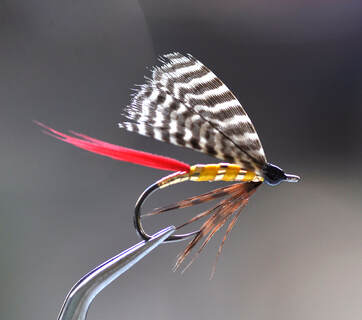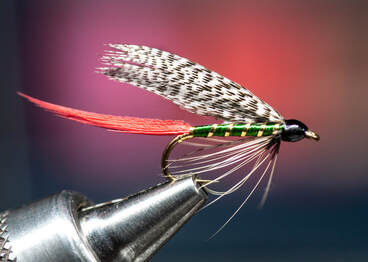Fly of the Month 05.19
This group of fly patterns are not as related in terms of materials and style as much as they are totally related to being created and tied by the same individual, a Scottish fly tyer named John Wilson who tied flies and authored books under the assumed name of Christopher North. Historically all these fly patterns have been traced back to his origin except King of Waters which is most likely his invention as well. About 1820 James Wilson was reputed “the best trout angler with the fly in Europe.”
Both John Wilson and his brother, James Wilson, were considered expert fly-fishers in their time and three of their fly patterns reflected such three-decades after John’s passing. After twenty-five years of fly-fishing experience, Wakeman Holberton, a well-known New York fly tyer classified flies according to their overall productivity in catching trout in the 1880s:
Most Killing Good Occasionally Good
Coachman Queen of Water Hooker
Shoemaker Professor Bee
Abbey Beaverkill
Grizzly King Cahill
Montreal
Note: Most killing means catches the most fish of course.
The Wilson Family of Fly Patterns
The Grizzly King is a fly pattern by Professor James Wilson, brother of John Wilson who is well-known for his fly pattern, the Professor. In his The Rod and Gun: The Treatises on Angling and Shooting book, published in 1840, he describes his fly pattern as: “The Grizzly King is a hackle par excellence. They call him Coomberland in the northern parts of merry England. His wings are broad and burly, formed of any undyed feather, bearing narrow natural bars of black and white, and he bristles with many stripes from head to heel, his dark green body being would about the gray or mottled hackle, and terminated by a fiery tail, turned up in what naturalists call an ensiform manner – that is, somewhat after the fashion of a sword.”
<scan drawing> “What seems his head, the likeness of a kingly crown has on.” thus, the name Grizzly King from the caption of a reproduction from “Rod and Gun.”
George M. LaBranche, of New York City, designed and developed the popular Pink Lady. LaBranche’s father’s favorite fly pattern, and consequently his, was a Queen of Waters. On preparing for a trip, and failing to obtain his desired patterns, the clerk sold him some flies called “King of Waters.” A king is not unlike the queen, except it has a scarlet body, instead of orange. In drying some after using, the red dye in the body faded to a pink. This pink bodied fly pattern, tied in LaBranche’s pattern with upright wings and a tail, in appearance no unlike the imago of the May fly, is the Pink lady.
George M. LaBranche tells of it in his fascinating book, The Dry Fly and Fast Water, written in 1914, rated as one of the best American trout books. He was one of the organizers of the Angler’s Club of New York, in 1905, and one of the incorporating directors of the National Association of the Scientific Angling Clubs, in 1909. LaBranche describes his fly pattern as: wings, medium starling or duck; body, pale pink floss, ribbed with flat gold tinsel; legs, ginger or light reddish-brown hackle; and, tail, three whisks of same.
John Wilson, 1785-1854 was the originator of the fly pattern named after him, the Professor. Wilson, educated at Oxford, noted for his skill in sports, beginning in 1817 wrote articles, many on angling, for Blackwood’s Magazine. Some of these are contained in the two-volume work entitled: Recreations of Christopher North, a book sometimes over-looked in the collection of an angling library. It was in 1820 that he became a professor in Edinburgh University.
History has it that on a fishing occasion he was without flies, and made one from petals of buttercups and grass, and a thread from a sock. This resulted in the creation of the buttercup yellow, silk bodied fly pattern known as the Professor.
Thomas F. Stoddard, in his book, The Scottish Angler, printed in 1835, says: “Foremost is the fly pattern commonly called the ‘Professor’ after Professor Wilson of Edinburgh. The wings are formed of a mottled brown feather taken from the mallard or wild drake; the body is of yellow floss silk, rather longish (the body, not the silk, which is trig and tightly wimpled) and wound about close to the head with a fine red or black hackle; tails are often used but we think them unnecessary. Instead of a yellow silk body we sometimes adopt one of pale green, especially in loch fishing.”
In the same author’s book Angler’s Companion, printed in 1847, Stoddard speaks of the Professor fly pattern as being: “dressed in coils of red hackle coming well unto the forepart of the chest.” The more modern dressing is with the yellow silk body, gold tinsel ribbed. The wings, grey mottled mallard. The hackle, brown. The tail, a bit of scarlet ibis feather. Then there is a variation in body color, a Blue Professor and a Gray Professor.
Remove the tag, make the body orange instead of yellow, wind the hackle palmer style, and one has the Queen of the Waters, a fly pattern also original with Christopher North and his naturalist brother, Professor James Wilson, author of The Rod and Gun: The Treatises on Angling and Shooting, published in 1840. In that book the Professor fly pattern is described by James Wilson as having, “wings usually composed of a mallard wing, barred by nature in the usual way, and varied in the ground-color by being dyed by art, lighter or darker, as may be deemed advisable. His body is formed of Paisley yellow floss silk, its texture rather tight and slim in form. It is not always advisable to try to hackle him, although he may sometimes be so slightly either with red or black about the shoulders, but his prevailing character is that of clearness, quietness, loveliness, and originality of composition, with a good deal of sarcastic sharpness about the barb, especially to bunglers who don’t understand the nature of the Kirby bend.”
Though the origin of the King of the Waters is not definitely known, as it is very similar, it may reasonably be presumed it also is one of the Wilsons.
The Wilson Family of Fly Patterns:
Grizzly King
King of Waters, Queen of Waters
Pink Lady
Professor, Blue Professor, Gray Professor
Fly of the Month 05.19
Tom Adams and Alen Baker
References:
Smedley, Harold Hinsdill. Fly Patterns and Their Origins, 1944
Bergman, Ray. Trout
Grizzly King Recipe
Hook : Streamer, Tiemco 5263 or equivalent size 8,10,12,14
Thread : Veevus 14/0 Black
Tail : Red Goose Shoulder
Abdomen: Green floss with gold flat tinsel
Wing : Mallard tail feather
Throat : Ginger hen hackle
Directions :
- Mount the hook in the vise after debarbing
- Start thread wraps at the mid point of the hook shank and advance in touching turns to the bend. Let the bobbin hang
- Select a small slip of red goose shoulder and after aligning the tips strip or cut away from the stem. Tie in on top of the hook shank with the feather covering two thirds of the shank. Make touching turns to cover the feather evenly and stop at three eye lengths back from the eye. Let the bobbin hang.
- Select a four inch piece of mylar gold flat tinsel and tie in. Make open wraps of thread will keeping the mylar on top of the hook shank. Secure with two or three wraps of thread. Advance the thread to three eye lengths from the eye and let the bobbin hang.
- Select a six to eight inch piece of green floss and tie in. Make even open wraps of thread to the point the tail is tied in while maintaining the floss on top of the hook shank. Secure with two wraps and advance the thread to three eye lengths from the eye and let the bobbin hang. Alternately, at this time, if you have a rotating vise, you can make a quick whip finish and move the thread to a bobbin rest. Doing that allows the vise to rotate to wrap the floss. Wrap the floss forward in slightly overlapping turns to build a tapered body and secure at the three eye lengths mark. Trim the waste and let the bobbin hang.
- Begin open, even turns of mylar to make ribbing to the thread and secure. Trim waste and let the bobbin hang.
- Select six or eight barbs of hen hackle and after making the tips even, strip or cut from the stem. Tie in under the hook shank with the length about touching the hook point. Trim waste and let the bobbin hang.
- Select a mallard tail feather and after aligning a dozen or so tips, cut or strip from the stem. Tie this in on top of the hook shank with a soft wrap for placement and secure with two firm wraps. Check for length, it should be about half of the tail in length and finish with several firm turns.
- Form a small tapered head with thread, whip finish and coat with head cement.
Professor
Hook : Streamer, Tiemco 5263 or equivalent size 8,10,12,14
Thread : Veevus 14/0 Black
Tail : Red Saddle barbs
Abdomen: Yellow floss with gold flat tinsel
Wing : Mallard tail feather
Throat : Brown hen hackle
Directions :
- Mount the hook in the vise after debarbing
- Start thread wraps at the mid point of the hook shank and advance in touching turns to the bend. Let the bobbin hang
- Select a dozen or so red saddle barbs and after aligning the tips strip or cut away from the stem. Tie in on top of the hook shank with the feather covering two thirds of the shank. Make touching turns to cover the feather evenly and stop at three eye lengths back from the eye. Let the bobbin hang.
- Select a four inch piece of mylar gold flat tinsel and tie in. Make open wraps of thread will keeping the mylar on top of the hook shank. Secure with two or three wraps of thread. Advance the thread to three eye lengths from the eye and let the bobbin hang.
- Select a six to eight inch piece of yellow floss and tie in. Make even open wraps of thread to the point the tail is tied in while maintaining the floss on top of the hook shank. Secure with two wraps and advance the thread to three eye lengths from the eye and let the bobbin hang. Alternately, at this time, if you have a rotating vise, you can make a quick whip finish and move the thread to a bobbin rest. Doing that allows the vise to rotate to wrap the floss. Wrap the floss forward in slightly overlapping turns to build a tapered body and secure at the three eye lengths mark. Trim the waste and let the bobbin hang.
- Begin open, even turns of mylar to make ribbing to the thread and secure. Trim waste and let the bobbin hang.
- Select six or eight barbs of hen hackle and after making the tips even, strip or cut from the stem. Tie in under the hook shank with the length about touching the hook point. Trim waste and let the bobbin hang.
- Select a mallard tail feather and after aligning a dozen or so tips, cut or strip from the stem. Tie this in on top of the hook shank with a soft wrap for placement and secure with two firm wraps. Check for length, it should be about half of the tail in length and finish with several firm turns.
- Form a small tapered head with thread, whip finish and coat with head cement.


